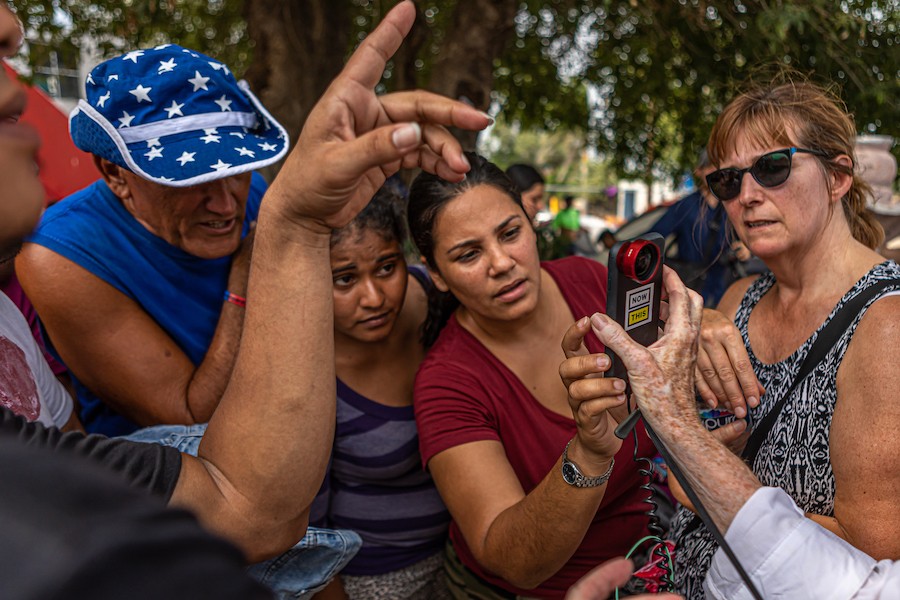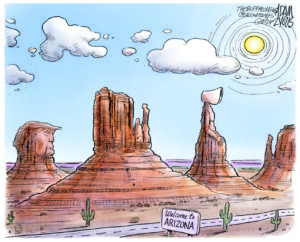The Deadly Myth of the Border
Greg Grandin’s latest book questions what is treated as inevitable when it comes to the U.S.-Mexico border. Immigration lawyers attempt to inform hundreds of asylum seekers of their legal rights in August 2019. (Michael Nigro / Truthdig)
Immigration lawyers attempt to inform hundreds of asylum seekers of their legal rights in August 2019. (Michael Nigro / Truthdig)
In my memories, the U.S.-Mexico border is always seen at night. I’m crossing home — how many times in my life? — through San Ysidro, Otay Mesa, Tecate, Mexicali. I’m bored, impatient, sometimes drunk in a rowdy car with more people than seats, other times sleepy after a vacation with my parents, still carrying Ensenada beach sand in my shoes. And suddenly there’s that border; bracing and somber; garishly lit; with its war-zone fencing and humorless guards. It does not exist in order to threaten me — I’m an American man, white, and with documents. Allegedly, it is my protection. But who, I have often wondered, takes comfort in the presence of razor wire?
Always near the car, a barefoot child selling pink chiclets. Or a teenage boy, sucking his checks, looking over his shoulder, testing his handholds on the fence. Men in white suits collecting change for charities. The limbless, in wheelchairs. Blanket vendors. Boys selling bottled water that is in reality tap water. A half-line floats up, from a poem I heard recently at a funeral, whose author I’ve never known: the grave has lost its victory / It is but crossing.
Listen to Luis Alberto Urrea tell the story of crossing la línea:
Border Patrol helicopters swoop and churn in the air all along the line. You can sit in the Mexican hills and watch them herd humans on the dusty slopes across the valley […] monstrous Dodge trucks speeding into and out of the landscape; uniformed men patrolling with flashlights, guns, and dogs; spotlights; running figures; lines of people hurried onto buses by armed guards; and the endless clatter of the helicopters with their harsh white beams. […] But the Mexicans keep on coming — and the Guatemalans, the Salvadorans, the Panamanians, the Colombians. The seven-mile stretch of Interstate 5 nearest the Mexican border is, at times, so congested with Latin American pedestrians that it resembles a town square.
That passage, from Urrea’s book ”Across the Wire,” was published 25 years ago. Has the ensuing quarter-century of economic migration, through a militarized border-zone of escalating punishments, been enough time for the United States to have learned even one single thing about the migrants who journey here? Apparently, no. Our spastic and cruel obsession with inflicting increasing levels of pain on the people trying to cross our Southern border has become, if anything, our biggest bipartisan national achievement. There are pundits in the United States who wring their hands over our “political discourse,” and the alleged failures of civility between opposing political parties. So perhaps it will cheer those people to know that the creation of this humanitarian disaster in the borderlands has been an enterprise of both major political parties, a beacon of Washington consensus-building in which Barack Obama and Jeff Sessions can find some common ground.
The U.S.-Mexico border is President Trump’s signature issue, and yet his understanding of the human beings who cross that border is a scrub wasteland too desolate to be called a desert. It takes an unfathomably impoverished mind to transform asylum-seekers, seasonal workers, day laborers, women, and children — infants, even — into an invading army. “Bad hombres,” “rapists,” “animals,” muscled men who “look like they should be fighting for the UFC,” caravans funded by George Soros which conceal Middle Eastern terrorists — these are lies that must be told to justify separating children from their parents, warehousing them on concrete floors without soap or toothpaste, all for the administrative “crime” of having not-yet-properly-documented a migration in duress undertaken by their parents.
If what is happening on our Southern border is truly an “invasion,” one that has been ongoing for decades, then let’s follow the logic out: What exactly has this “army” achieved? What battles have its “soldiers” won? If migrants-without-papers from Central America and Mexico are hell-bent on American destruction, their guerilla methods of sabotage seem largely to involve harvesting strawberries, hanging drywall, dicing mirepoix in Michelin-starred restaurant kitchens, cleaning houses, pruning hedges, serving in the United States military, attending college, writing poetry, and paying billions into Social Security coffers never to be collected. These were not exactly the methods employed by the Visigoths when they sacked Rome.
There are criminals, of course, who cross the border with contraband, running drugs north or money and guns south. But anyone who fears drug cartels should understand that cartel violence is precisely what many of these migrants are fleeing from. It remains baffling to me that someone horrified by garish reporting on MS-13 would not also understand that the extortion and murders carried out by MS-13 are exactly what has caused many El Salvadorans to leave home. (And also, let’s recall, MS-13’s gang of murderers was born in the same place Stephen Miller was: Los Angeles.) It’s as though an American in a BarcaLounger in Dubuque, with Fox News on at full volume, is allowed to be afraid of a Central American gang war, but an actual family under threat from that war has no similar right.
The solution to our borderland crisis is not, and never will be, a wall. Some measure of historical knowledge helps make that clear, and an understanding the historical folly of our borderland policing can also point to a better way forward. This is why Greg Grandin’s recent book, “The End of the Myth: From the Frontier to the Border Wall in the Mind of America,” comes at such an opportune time. It’s a book I would recommend to President Trump in particular, though of course he wouldn’t read it. In the end, the only advice to give a grown man who believes we require a 2,000-mile, 30-foot-high concrete wall to protect us from seven-year-old Guatemalan girls, is that he should stop leaving the house, lest he be assaulted by the specter of his own shadow.
Click here to read long excerpts from “The End of the Myth” at Google Books.
For most of American history, the frontier wilderness — the land beyond our border — was imagined as a masculine proving ground, a place of “regeneration through violence,” as the historian Richard Slotkin terms it. In this myth, the white hunter-hero battles against the Indian in the name of settlement and civilization. Recall Presidents Reagan or George W. Bush, in boots and Wranglers against a ranch-land sky, rhetorically leveraging the rough justice of the Old West whenever they needed to transform the politics of bullying death into a morality play.
President Trump, by contrast, is too lazy to clear brush with an adopted cowboy swagger, and his administration’s border fantasies are mostly too unhinged to conform to the well-worn tropes of the “Old West.” But as Trump stands in his golf shoes at the Mar-a-Lago omelette bar, telephone-game mangling xenophobic anecdotes from that morning’s “Fox & Friends,” he has unwittingly invented a new American genre. Gone is the day of the Border Western. Now is the era of Border Horror.
Consider the rhetoric: we are under siege. We must retreat. We must fortify ourselves, behind the tallest walls. We must, in other words, take shelter and hide. This vision of America resembles nothing so much as a barely coherent spin-off of “The Walking Dead,” wherein a group of hounded and heroic survivors — in this case, the 300 million residents of the richest country on earth — are besieged by zombie hordes, in the form of women and children from the poorest countries in the hemisphere. The red-hatted MAGA crowd seem to imagine themselves tending the last flame of civilization, and as a result can’t be bothered by moral claims for the rights of zombies, or worry over the conditions the brain-eaters are imprisoned in, and refuse to feel any guilt about tearing the interloping undead away from their equally undead children. This is what regeneration through violence looks like when reborn as Border Horror: the zombies coming over the walls must be caged, fought, or killed, and nothing else.
It’s worth asking how we arrived at this era of Border Horror. Why has the world outside our borders grown so frightening to us, at this, the apex of our reach and power and wealth? Expansion of our influence into that world used to be imagined an end in itself. What Greg Grandin argues in “The End of the Myth” is that the United States has always “pushed outward and justified that push in moral terms, as beneficial equally for the people within and beyond the frontier.” Indeed, founding figures like Benjamin Franklin were “optimistic Promethean[s],” Grandin writes, who “imagined history as a propulsive movement across the sea and land, east to west.” Or, as President James Monroe succinctly put it, “the greater the expansion, the greater the advantage.” (To be clear: Grandin is describing the history of this expansionist attitude, not endorsing it.) This propulsive drive to push forward the American project accounts not just for territorial expansions like the Louisiana Purchase, but for the U.S.-Mexico border in its current iteration, the product of a land grab that cleaved Mexico in half in 1848 as the spoils of a manufactured war. “Politics,” Grandin argues, was long organized around “the promise of constant, endless expansion.”
So deep this expansionism in American history, that ideas of boundedness long remained the fringe bugbear of nativists of the Pat Buchanan ilk. “You don’t build a nine-foot fence along the border between two friendly nations,” Ronald Reagan said in 1980. “You document the undocumented workers and let them come in here with a visa for whatever length of time they want to stay.” (Grandin’s book spills over with unearthed gems like this, ripe for the Thanksgiving dinner table arguments.) If “America’s exceptionalism was born on a frontier thought to be endless,” as Grandin says, then President Trump’s embrace of “the wall” represents by contrast the mainstreaming of a fortress mentality once considered antithetical to the American identity. Every other president spoke of braving new frontiers. For Trump, the United States is nothing more than a condo development in which all the units have been sold, where preserving our gilt privilege comes at the cost of closing the doors, pulling the shades, and huddling forever in the dark.
On its face, the end of the frontier myth — by turns racist, genocidal, expropriative, and sentimental about the motives of its white settler-heroes — should be nothing to mourn. But as contradictory and violent as the frontier myth was, the doctrine of expansionism was the way America served to manage its unruliness. “For over a century, from Andrew Jackson forward, the country’s political leaders enjoyed the benefit of being able to throw its restless and angry citizens […] outward into campaigns against Mexicans, Native Americans, Filipinos, and Nicaraguans, among other enemies,” Grandin writes. The westward drive meant Indian removal and eventually war with Mexico. Later, what the Civil War cleaved apart an expansionist war with Spain in the Philippines was able to knit back together. “The War of 1898 and the serial wars that followed allowed southerners to reclaim admission into the nation without having to renounce their white supremacy,” Grandin argues. The pattern is clear: again and again, racial and social conflicts are pushed outward, deferred from one war into the next, until finally the new frontiers become Vietnam and Iraq and Afghanistan.
At the core of Grandin’s argument is this idea that a state of constant warfare, enabled by the frontier myth, meant that extremism always found an outlet beyond the line of American settlement. Each new expansion could expend the unresolved passions of the last expansion. But when that animating myth, however naïve or self-serving, falls away, what lies exposed at home are all of the contradictions the myth once deferred. Once “[e]xpansion, in any form, can no longer satisfy the interests, reconcile the contradictions, dilute the factions, or redirect the anger,” Grandin concludes, we’re left with Trumpism — “extremism turned inward, all-consuming and self-devouring.”
We might, as a country, have moved beyond our frontier mythos in a more honest and self-reflective fashion, via a moral reckoning with our expansionist past, a collective renunciation of colonial land grabs and wars beyond our boundaries, and a new dedication to living within our borders as a nation devoted to racial and gender equality. What happened instead Grandin lays out in a brilliant, blistering summation near the end of his book:
For over a century, the frontier served as a powerful symbol of American universalism. It not only conveyed the idea that the country was moving forward but promised that the brutality involved in moving forward would be transformed into something noble. Frontier expansionism would break every paradox, reconcile every contradiction between, say, ideals and interests, virtue and ambition. Extend the sphere, and you will ensure peace, protect individual freedom, and dilute factionalism; you will create a curious, buoyant, resourceful people in thrall to no received doctrine, transcend regionalism, spread prosperity, and moved beyond racism. As horizons broaden, so will our love for the world’s people. As boundaries widen, so will our tolerance, the realization that humanity is our country. There was no problem caused by expansion that couldn’t be solved by more expansion. War-bred trauma could be rolled over into the next war; poverty would be alleviated by more growth.
But today the frontier is closed, the safety valve shut. Whatever metaphor one wants to use, the country has lived past the end of its myth. Where the frontier symbolized perennial rebirth, a culture in springtime, those eight [border wall] prototypes in Otay Mesa loom like tombstones. After centuries of fleeing forward across the blood meridian, all the things that expansion was supposed to preserve have been destroyed, and all the things it was meant to destroy have been preserved. Instead of peace, there’s endless war. Instead of a critical, resilient, and progressive citizenry, a conspiratorial nihilism, rejecting reason and dreading change, has taken hold. Factionalism congealed and won a national election.
This is as bracing an analysis of post-2016 America as any I have read. Grandin’s book is so sharply argued, so rooted in careful historical detail, so morally clear, that it makes a strong claim to be the most essential political text yet to emerge from the shock of Trump’s election.
In the summer of 2019, Trump visited the border town of Calexico, California, a few miles from where I grew up. “We’re building a lot of wall,” Trump said. “We’re going to look at a piece of it today. And I was just told it had a tremendous — it’s had a tremendous impact already — the piece that we’re going to be looking at.”
In truth, substantial border fencing in Calexico has existed since 1945. In fact, as Grandin’s book reminded me, the physical structure of that Calexico fence — the wire mesh and fence posts — was recycled from the Crystal City Internment Camp, where Japanese Americans were confined during World War II. It’s unlikely, of course, that Trump is aware of any of the fence’s actual history, or the implicit critique repurposed internment camp fencing offers of his border policies.
On any number of occasions, Trump’s own advisors — blustering anti-immigrant hardasses like former chief of staff John Kelly — have tried to help Trump walk back the ludicrousness of a physical concrete wall across the entirety of the border, not on grounds of compassion or economic realism, but strictly because a border wall is the kind of policy solution that only makes sense if you’ve lived your entire life inside the gates of a country club. Trump has explicitly rejected every offer of education about his own policies: “An all concrete Wall was NEVER ABANDONED, as has been reported by the media,” he wrote on Twitter, in response to Kelly’s exceedingly gentle attempt to reframe Trump’s stupid, infeasible idea. A concrete wall, as a concept, is inarguably rhetorically and politically effective, which could lead a person to conclude that Trump knows the wall is ridiculous, but like any good con artist, has simply identified a grift that works. But I would venture to guess that Trump passionately and sincerely believes in his dumb idea.
President Trump wants a border wall where right now all that exists are mere hundreds of miles of fences, double-fences, fences out into the ocean, sensors, deep canals, boiling deserts, swift rivers, helicopters, SUVs, Border Patrol agents with night-vision goggles, vigilante racists self-deputized to patrol the scrublands, and forbidding mountain passes. He wants this wall because historically, he says, walls work. Historically, he is incorrect, but we shouldn’t pretend this border wall ever existed in the realm of an evidence-based history. There is no careful study of the Ming Dynasty happening inside of the Department of Homeland Security.
And yet, one consequence of the napalm of stupidity airdropped on our population daily from the White House has been a deforestation of conversation about any other subject besides the Trump administration. There’s always another dose of evil with which a Stephen Miller, a Kirstjen Nielsen, a Sarah Sanders, a Pompeo or Bolton has ravaged and burned the truth, and we feel duty-bound to attend to it. But it’s also true that in opposing Trump, we risk overstating, even increasing, his power and reach. One essential use of a historical analysis like Grandin’s is to reopen inquiry into lost possibilities, to pay attention to what the present has muted, to discover the hand of contingency in what is treated as inevitable.
Looked at historically, then, what you find is that the U.S.-Mexico border is only a burial ground because we have made it so. It is only a place where the Constitution is held in abeyance because we have allowed it to be. It is a place where Border Patrol agents can act with impunity precisely because we have blessed that impunity. And there is inhumanity at the border only because we have refused to treat people crossing the border as fully human.
Let’s return to the migrant — let’s put him or her or them at the center of a conversation we tend to have only in self-interested terms. We speak all the time of “our” laws, and these people who are “breaking” them. Or, if we are more generous, we speak of what these people can do for us — what labor or services they can perform inexpensively on our behalf. But what if we just consider, from their perspective, who these people are, and what they are doing? Luis Alberto Urrea writes:
Imagine how bad things get to make you leave behind your family, your friends, your lovers; your home, as humble as it might be; your church, say. Let’s take it further — you’ve said good-bye to the graveyard, the dog, the goat, the mountains where you first hunted, your grade school, your state, your favorite spot on the river where you fished and took time to think.
Then you come hundreds — or thousands — of miles across a territory unknown to you. […] You have walked, run, hidden in the backs of trucks, spent part of your precious money on bus fare. […] Various features of your journey north might include police corruption; violence in the forms of beating, rape, murder, torture, road accidents; theft; incarceration. Additionally, you might experience loneliness, fear, exhaustion, sorrow, cold, heat, diarrhea, thirst, hunger. There is no medical attention available to you. There isn’t even Kotex. […]
[In Tijuana,] [y]ou’re in the worst part of town, but you can comfort yourself — at least there are no death squads here. There are no torturers here, or bandit land barons riding into your house. There is the last barrier, you think, between you and the United States.
At the moment, that last barrier is playing the role of the worst barrier. Is that who we wish to be? There is no ethical teaching anywhere, secular or sectarian, for believers and unbelievers alike, that suggests that what we are doing at the border is admirable behavior for the powerful to show to the weak. There is certainly nothing in the Bible that says this is how you treat the poor, the stranger, the widow, or the orphan. But the choice between the teachings of Jesus, and the ramblings of Trump, is one the vast majority of evangelicals decided long ago in the president’s favor. This is the horror at our border: the poor will be offered no comfort. The meek will inherit the dirt.
This review originally appeared on the Los Angeles Review of Books.
Your support matters…Independent journalism is under threat and overshadowed by heavily funded mainstream media.
You can help level the playing field. Become a member.
Your tax-deductible contribution keeps us digging beneath the headlines to give you thought-provoking, investigative reporting and analysis that unearths what's really happening- without compromise.
Give today to support our courageous, independent journalists.







You need to be a supporter to comment.
There are currently no responses to this article.
Be the first to respond.